Why do the ovaries of cucumbers fall off and what to do to save your harvest?
Cucumbers are not a fastidious crop, but gardeners often have problems when growing them. It happens that the ovaries turn yellow and begin to fall off, which leads to a sharp decrease in yield. The process can be stopped if the cause is identified in time and adjustments are made to care measures.
Why the ovaries of cucumbers fall off and what to do about this problem, we will tell you in the article.
What threatens the fall of cucumber ovaries?
Beginners in gardening often face the problem of cucumber ovaries falling off. Because of this, the yield is significantly reduced, and in particularly advanced situations it is not enough even for summer salads. After the first unsuccessful experience, novice gardeners give up, believing that it is impossible to grow a lot of tasty and aromatic cucumbers on their plot.
Important! Do not worry if only a small part of the ovaries turn yellow and fall off - this plant is shedding excess load in order to free up resources for the ripening of existing fruits.
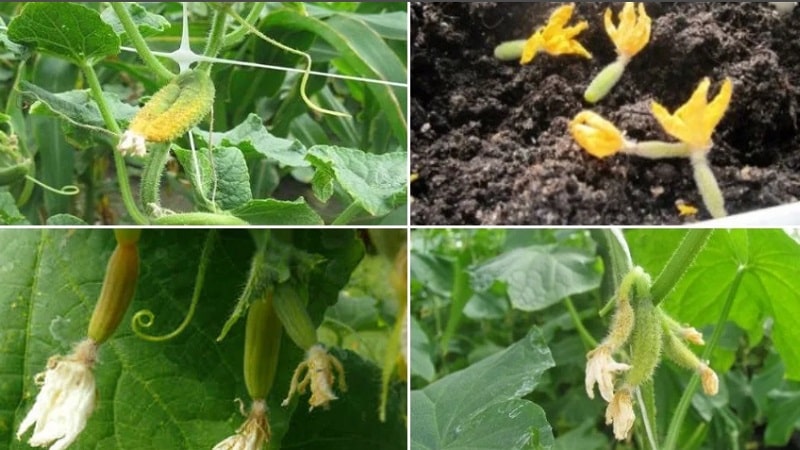
Causes of the problem
There are several reasons that lead to crop loss due to the fall of the ovaries. Let's take a closer look at them.
Too dense plantings
For the ovaries and fruits to form, It is necessary to give each plant sufficient light and air. Therefore, the crop is planted taking into account the feeding area of each bush.
Cucumbers are placed in the greenhouse as follows:
- when planting hybrids at 1 m2 do not plant more than two bushes;
- pollinated varieties - 2-3 bushes per 1 m2.
Bushes are not formed
Novice summer residents believe that form bushes growing cucumbers is not advisable, as the yield will decrease. But practice shows that this statement is wrong. Stepchildren not only take nutrients and moisture from the main plant, but also prevent new fruits from forming.
Several times during the growing season, shoots that have no ovaries are removed. They not only impede air circulation, but also provoke infectious diseases.
All layers formed in the axils of the first 3-6 true leaves are completely removed. The stepsons that have grown higher are pinched, leaving two leaves on them.
Stems formed in the stepson axils pinching after the first sheet.
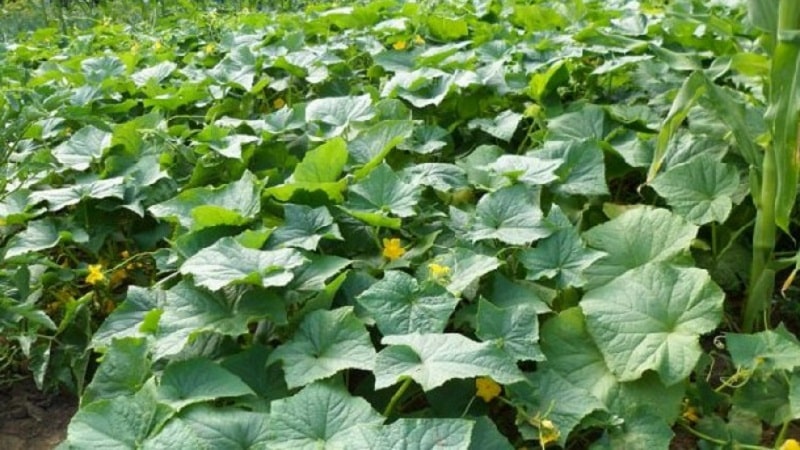
Lack of pollination
All varieties and hybrids, except self-pollinating, need to transfer pollen from male flowers to female flowers. This process is facilitated by insects. To increase the fruiting of each bush, a greenhouse is constantly opened in the warm season, so that bees can freely fly up to the plants.
If the summer is rainy, then they resort to hand pollination. This is not difficult to do: pick a male flower and gently pass it along the female pistil, or use a soft brush to transfer pollen
Variety problems
Before you buy planting material for sowing cucumbers, decide where you will cultivate them. For closed ground, it is better to choose hybrids that do not require pollination by insects. – Adam f1, Director f1, Emerald earrings f1, Tempo f1.
For open beds, choose low-growing bee-pollinated varieties – they do not require pinching and arrangement of a large trellis system; small wooden pegs for gartering are sufficient. Suitable varieties are Korotyshka, Kustovoy, Mikrosha, Hector.
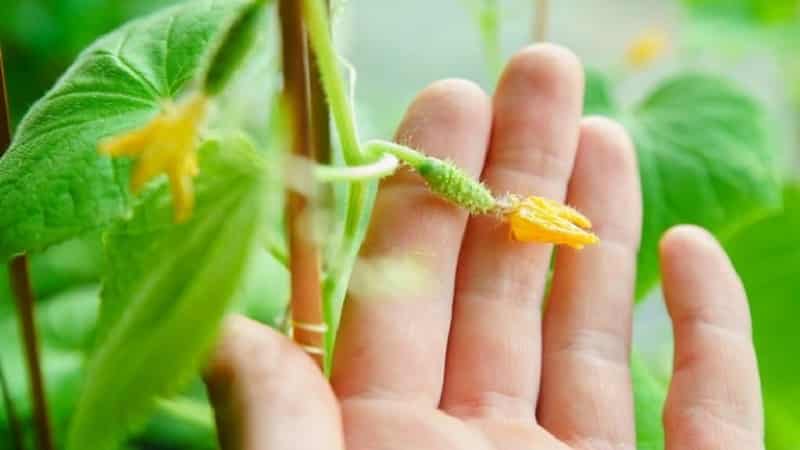
Mistakes when watering
Cucumbers require regular and abundant watering. If you violate irrigation mode, the ovaries will begin to turn yellow and fall off.
Experienced gardeners advise strictly following the rules of watering in the greenhouse:
- use only warm, settled water at a temperature of +23°C - cold liquid not only weakens the plant’s immunity, but also reduces the number of female flowers;
- in hot weather, irrigate early in the morning to prevent rapid evaporation of moisture;
- in cool weather, water during the day so that the earth warms up in the evening.
Excess moisture can create a large amount of condensation in the greenhouse., because of which fungal infections will begin to develop, the bushes will become sick, which is fraught with complete loss of the harvest.
Cucumbers are provided with comfortable humidity level in accordance with the needs of plants at different stages of the growing season:
- before the flowering period begins, the bushes need a lot of moisture, so they water every seven days, 4 liters per 1 m²;
- as soon as the first flowers appear, water daily;
- After flowering ends, water the cucumbers once every 2-3 days so that the fruits fill faster, are juicy and not bitter.
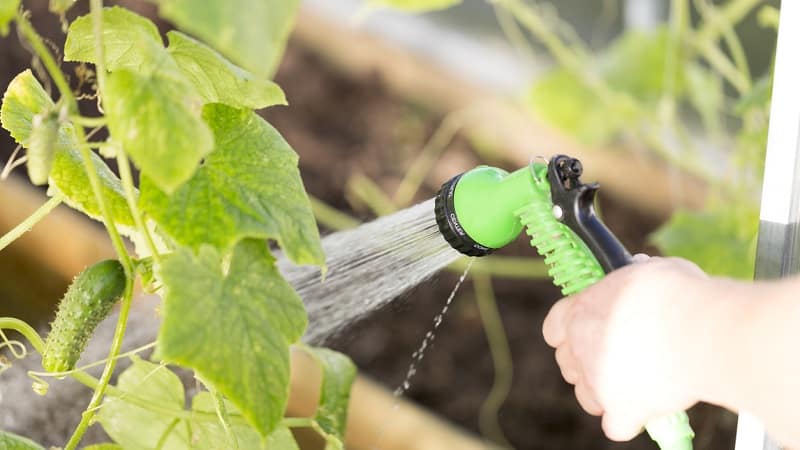
Diseases
Infections provoke rapid yellowing and drying of the ovaries. Bacterioses are the most dangerous - they affect weak plants or dense plantings, especially if there are strong temperature changes in the greenhouse.
If the plant looks healthy but gradually begins to wilt from the top – this is probably root rot. The disease blocks the supply of micronutrients to all parts of the bush, and the ovaries quickly fall off.
Unsuitable temperature conditions
Too cold or hot weather can have a detrimental effect on cucumber plantings. If the crop is grown in a greenhouse, organize constant ventilation, especially if the weather is hot.
As soon as the autumn cold snaps begin, the plantings are insulated. Agrofibre is ideal - it allows plants to breathe and does not provoke the formation of condensation.
Why do cucumber ovaries turn yellow and fall off in a greenhouse?
Yellowing of the ovaries may be caused by improper agricultural practices:
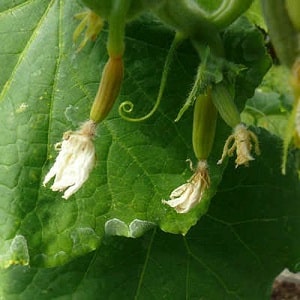 unprepared planting material and soil;
unprepared planting material and soil;- incorrectly selected disembarkation time;
- failure to maintain the distance between bushes;
- ignoring the formation of bushes.
Dealing with the consequences of a problem is always more difficult than preventing it. Before planting cucumbers in a greenhouse and during plant growth, preventive measures are taken to help avoid shedding of the ovaries:
- choose zoned varieties of cucumbers, that is, the most suitable for growing in a greenhouse in your region;
- place the greenhouse in a sunny area so that shadows from buildings and trees do not fall on it;
- before planting and during flowering, complex fertilizers are applied to the soil;
- strictly adhere to the watering schedule;
- if there are a lot of ovaries, remove some of them to relieve the plant;
- monitor the temperature;
- Ripe fruits are collected in a timely manner.
In the open ground
Failure to comply with agricultural practices when growing cucumbers in open beds leads to yellowing of the ovaries.
There are several reasons:
- untimely harvesting - a large number of ripened fruits signals the plant that it has fulfilled its purpose, and the bush begins to wither;
- strong temperature changes are a stress during which small roots begin to die, nutrition becomes worse, and ovaries fall from the bushes;
- watering with cold water - the water should be warm and settled;
- unformed bushes - when the plantings are thickened, the plants lack light and fresh air, which provokes the development of diseases and yellowing of the ovaries.
How to save the harvest
To save the harvest identify the cause of wilting and falling of the ovaries.
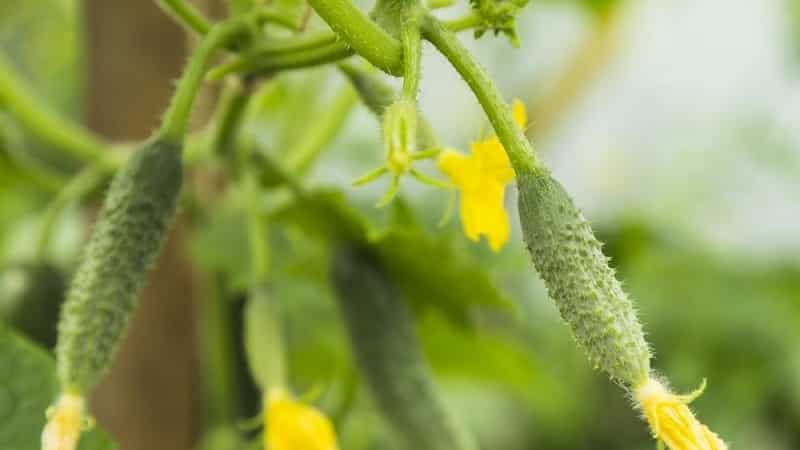
Universal recommendations from experienced gardeners:
- add a complex of fertilizers - “Ammofoska”, “Diammofoska”, potassium sulfate are suitable;
- apply traditional methods - fertilize with urea and wood ash;
- ensure complete pollination of flowers - in closed ground this can be done manually, in open ground they attract bees;
- remove excessively growing stepsons and properly form the bush;
- destroy pests using folk remedies or drugs “Decis”, “Inta-vir”.
Preventive measures
To avoid problems, Preventive measures are taken before planting:
- buy high-quality planting material and treat the seeds;
- Self-pollinating varieties and hybrids are planted in the greenhouse, since it is difficult for insects to get there;
- think over the landing site - it should be in an open, illuminated area without drafts;
- the location of the beds is changed every year;
- cover plants in the open ground from the scorching sun, arranging a canopy that will save the crop from burns;
- During heavy rains, grooves are dug to drain excess moisture.
Tips and tricks
Summer residents who have been growing cucumbers for more than one year advise beginners cover your plantings at night with agrofibreto prevent the ovaries from falling off.
The root system of the plant is extensive, therefore when watering, it is worth considering that moisture must penetrate deep into the soil no less than 40 cm.
Particular attention should be paid to seeds. All experienced gardeners harden them off before planting so that they germinate faster and the seedlings are stronger and more resistant to diseases.
Conclusion
If action is not taken at the first sign of yellowing of the ovaries, there is a risk of losing the entire harvest. Reasons for the falling of ovaries: diseases, pests, non-compliance with growing rules. If you follow the recommendations of experienced gardeners, then the fall of the ovaries can be prevented and you can get a full harvest on time.